| |
In 1795 most of Belarus was annexed by the Russian Empire under the
rule of tsarina "Catherine the Great". From 1835 to 1915, the Grodno
region (including Lunna-Wola) was part of the "Pale of Settlement", an
area designated for Jewish settlement. In 1880, 4.8 million Jews lived
in this restricted area which comprised Belarus, Lithuania and most of
Ukraine (within todayís boundaries) and were granted certain rights
which were previously denied by Polish rulers.
Jewish communities in Lunna-Wola were further developed during the
second half of the 19th century. The 1851 census notes the Jewish
population in Lunna to be 595 residents including 228 males and 367
females. The low male count possibly reflects service in the army
and/or casualties during military service. In 1872 Jews of Lunna
organized a donation to assist the poor Jewish population in Persia.
There is a List of
Donors in
Hamagid 3 April 1872 (no. 14, p.11).
At the end of the 19th century there were 1,364 Jewish residents in
Lunna-Wola, which comprised 75% of the total population.
Education of Jewish children began in a "Cheder", initially was
restricted for boys and later, though separate, included girls. In the
"Cheder" the children studied fundamentals of Judaism including:
Chumash, Gmarah and the Jewish prayers. According to the 1872 donors
list, there were two teachers in Lunna: Binyamin Gradzenski and
Menachem Weidson. It is most likely that they were teachers in the
Cheder. In 1874 Netanel Wolf Labshitz from Lunna published an article
in
Ha'Levanon Journal, no. 46 (page 367). In this article he
advocated for the establishment of Jewish trade schools in the Russian
Empire.
In 1907, the modern Cheder ("Cheder Metukan") was established in Lunna
with the help of Chaim Sorin, Feivel Mattis and Shishatsky. In the
modern Cheder the children studied Hebrew and other subjects in
addition to the Jewish studies.
Note: Chaim Sorin was born in Lunna in 1887. Feivel Mattis (b. 1885)
was a Hebrew teacher who came to Lunna from another town in the
Russian Empire. It is conjectured that the first name of Shishatzky
was Hyman (Chaim) who was born in Lunna in 1887. (See:
Memoirs/Sorin).
According to a 1910 Memorable Book of the Grodno Province there was
also a Russian rural school in Lunna and the teachers in charge were:
Iushko and Gutkovskiy.
There
were synagogues in Lunna and in Wola. Because Lunna and Wola were not
yet united, each Jewish community had its own Rabbi and Shochet.
Sometimes there were disagreements with respect to the level of
Kashruth for meat which was bought outside the town.
Lunna's Rabbis included: Rabbi Eliahu, son of Reb Benjamin Shik, Rabbi
Yitzchak-Tzvi Pomerantz-Rubinstein, and Rabbi Mordechai, son of Rabbi
Yedidia Pesach (Briep). One of the Wola's Rabbis was Rabbi Abraham,
son of Moshe-Nathan Zakhaim.
Rabbi Eliyahu Shik (born in 1809), known as Rabbi Elinka, functioned
in Lunna sometime around 1850. Later on, he was a Rabbi in Derechin,
Lida, Zager and then in Kobrin where he died in 1874. He is the writer
of "Ein Eliyahu" which contains commentaries to "Ein Yaakov". The
first volume of "Ein Eliyahu" includes his biography.
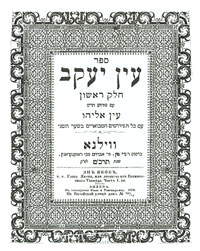
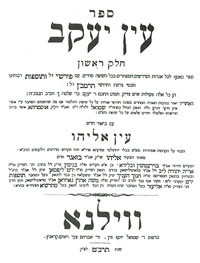
The front page of the book "Ein Yaakov" with commentaries "Ein Eliahu"
(first volume)
Rabbi Yitzchak-Tzvi Pomerantz-Rubinstein
was Av Beit Din (Head of the rabbinic court) during the 1870's. In the
book "Yad Eliezer" written by Rabbi Eliezer, son of Rabbi Yehuda
Nitzberg, Rabbi Yitzchak-Tzvi was described as genius ("Yillui").
Rabbi Mordechai, son of Rabbi Yedidia Pesach (Briep), functioned
between 1885 and 1910 as the head of the rabbinic court. He wrote the
books "Darchei Mordechai", published in 1887, and "Chakal Tapuchim",
published in 1896. He added to his book the "Kontrast Hatzaba" [note:
"Tzaba"- abbr. to: Tzvi ben Aaron] by Tzvi-Hirsh, Aaron Arkinís son of
Lunna. Rabbi Abraham, son of Moshe Nathan Zakhaim, functioned as a
Rabbi in Wola before the First World War. He was the son-in-law of the
famous Rabbi Hillel Trivosh and is the writer of "Nitei Eithan"
(Plants of Eithan).
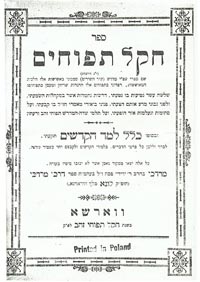
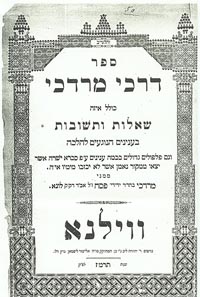
Under the Russian Empire, Jews were drafted to the Russian army. Many
Jews tried various methods to avoid conscription. Some tried to change
their names, others tried to register in towns other than the one they
grew up while others chose to self-mutilate themselves by various
methods including cutting a finger.
A list of 1880 Russian Army
Deserters includes the following Lunna residents: Aron-Chaim Kagan,
Moshe-Itsko Katsel, Kostel Kurazh, Girsh-Yaakov Lachin, Nachman-David
Lyubitz, Shlomo Ostile, Mordko Rubinov, Girsh Shmigelsky and Zusman
Taplitsky. In the period between 1880 and the First World War, due to
resistance to the draft to the Russian army and consequent to the
detrimental economical conditions, there was a wave of immigration of
Jews from the Russian Empire to the Unites States, Argentina, South
Africa and to other destinations.
A map of Jewish emigration from
Russia during the period between 1889 and 1928 is available.
The Ellis
Island website under the sub-site "Lunna" (and other spellings, such
as: Luna and Luno) lists of more than 150 individuals who entered the
USA via Ellis Island during the first two decades of the 20th century.
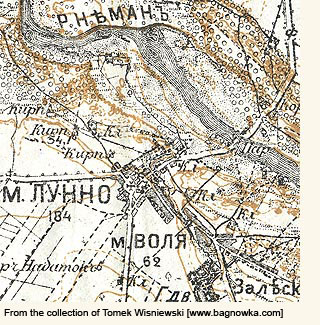 The
1900 map of Lunna (the only existing detailed map) illustrates the
center of the town as a circled square surrounded by residential and
religious buildings. The Pravoslavic (Russian Orthodox) Church was
located in the middle of the square. East of the church stood two
synagogues (marked by two zodiac symbols). Nearby, there was a
catholic church. The map also shows roads leading from the center of
the town in four directions. Along the South-East road leading to
Wolpa (11.4 kilometers) were the houses of Wola surrounded by small
farms and a mansion (marked with a symbol G. db-Grazdansky Dvor) and a
forest. The road toward the North crossed the Niemen River via a
bridge and led to Skidel (15 kilometers). There were brick factories
(marked by two symbols of Krip) at the North-West direction. At the
South-West direction, there was a stream (marked as Wodotok). There
were five cemeteries (marked by Ki - Kladbiszcze); two Christian
cemeteries (marked by a cross), and three Jewish cemeteries located
South-West to the Niemen River (the "old" and "new" cemeteries of
Lunna and the cemetery of Wola.)
The
1900 map of Lunna (the only existing detailed map) illustrates the
center of the town as a circled square surrounded by residential and
religious buildings. The Pravoslavic (Russian Orthodox) Church was
located in the middle of the square. East of the church stood two
synagogues (marked by two zodiac symbols). Nearby, there was a
catholic church. The map also shows roads leading from the center of
the town in four directions. Along the South-East road leading to
Wolpa (11.4 kilometers) were the houses of Wola surrounded by small
farms and a mansion (marked with a symbol G. db-Grazdansky Dvor) and a
forest. The road toward the North crossed the Niemen River via a
bridge and led to Skidel (15 kilometers). There were brick factories
(marked by two symbols of Krip) at the North-West direction. At the
South-West direction, there was a stream (marked as Wodotok). There
were five cemeteries (marked by Ki - Kladbiszcze); two Christian
cemeteries (marked by a cross), and three Jewish cemeteries located
South-West to the Niemen River (the "old" and "new" cemeteries of
Lunna and the cemetery of Wola.)
This site is hosted at no cost by JewishGen, Inc., the Home of Jewish
Genealogy. If you have been aided in your research by this site and
wish to further our mission of preserving our history for future
generations, your
JewishGen-erosity is greatly appreciated.
|
Compiled by
Ruth Marcus & Aliza Yonovsky Created
May 2007
Updated by rLb, March 2020
Copyright © 2007 Ruth Marcus
All the photos are presented
by courtesy of the families and are not allowed to be reproduced
without their permission. |
|
|